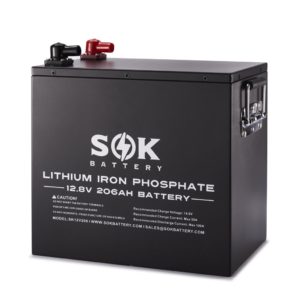SOK Battery Review
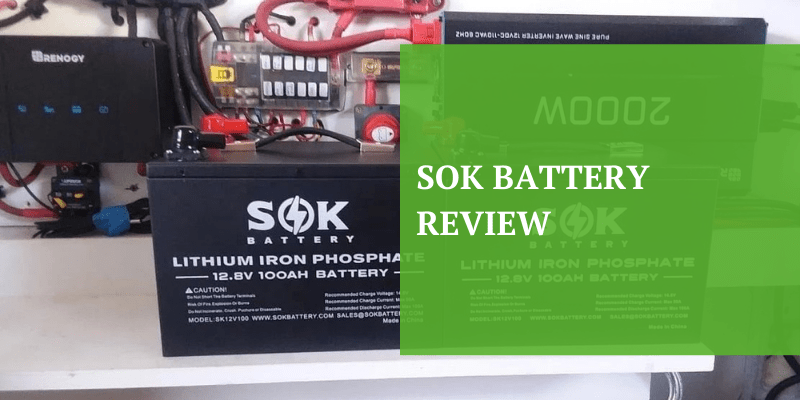
Written by qualified solar engineer Carlos. Last updated:
Table of Contents
SOK Battery manufactures and supplies LiFePO4 batteries and is one of the leading manufacturers in the market.
Lithium iron phosphate (LiFePO4) batteries are a rechargeable battery that uses LiFePO4 as the cathode material and a graphitic carbon electrode as the anode. Because of low cost, low toxicity, well-defined performance, and long-term stability, LiFePO4 batteries are finding multiple applications in vehicle use, utility-scale stationary applications, and backup power.
The SOK 100Ah and 200Ah batteries are some of the best-selling LiFePO4 batteries due to their uses. These batteries are perfectly suited for RV’s, Off-grid cabins, and all kinds of energy-powered devices.
Here, you will learn about the SOK 100Ah and 206Ah LiFePO4 batteries product features and specifications and compare the specs of both batteries to others manufactured by leading competitors.
Who is SOK Battery?
SOK battery is a Chinese manufacturer and supplier of LiFePO4 batteries that lead the market, established around 2015 by a team of three engineers from CALB, a company with multiple branches worldwide.
The LiFePO4 Batteries the brand produces are superior to lead-acid batteries due to features like high specific energy, longer life cycles (3000~8000 cycles), compact size and lightweight, high thermal and chemical stability, and best safety and cost performance.
SOK 12.8V 100Ah Battery: Product Features and Specs
This battery has four built-in LiFePO4 battery cells of 3.2V 100Ah in series, with low-temperature cut-off protection that allows its use in cold places. It can be connected in series for 24V, 36V, or 48V battery banks or connected in parallel for larger capacity. The following specifications and features of this battery are listed below:
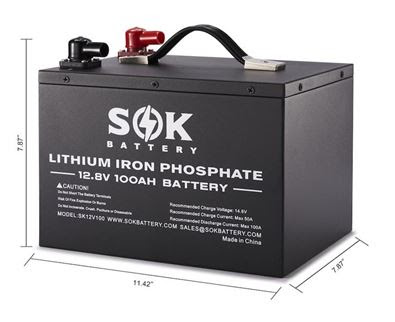
Figure 1. SOK LiFePO4 12.8V 100AH Battery –SOK Battery
Weight & Size
One of the most notorious features of the SOK 100Ah LiFePO4 battery is its physical size since it is lightweight and compact. It weighs 26lbs and has dimensions of 11.42×7.87×7.87 inches.
Battery Capacity & Current
SOK 100Ah has a battery capacity of 1,280Wh or 100Ah at an operating voltage of 12.8V, has a maximum charge current of 50A, and a maximum discharge current of 100A.
Internal design
This battery uses robust seven-inch wires to join the external connectors with the internal array of four removable lithium prismatic cells in series. It features a cover of isolating material and a quality Battery Management System (BMS) for protection, which you can remove, all inside a metal case.
Built-in Smart BMS
One awesome feature that the SOK 100Ah battery has is the capacity to detach and replace BMS or Cells, making these batteries adaptable to customers’ needs. This BMS protects against overcurrent, short-circuits, and high & low temperatures, preventing the battery from malfunctioning.
Higher life cycle and warranty
One of the benefits of including prismatic lithium cells in the SOK 100Ah battery is the higher life cycle, providing up to 8000+ cycles for normal usage and 4000 cycles for heavy-duty usage with free maintenance. Also, the SOK battery set a 7-years warranty over the SOK 100Ah battery and lifetime customer support.
SOK 206Ah Battery: Product Features and Specs
A battery nearly identical to how the SOK 100Ah battery is built with, 4 pieces of LiFePO4 battery cells of 3.2V in series, with cut-off protection and options to connect in series, or connect in Parallel. The following specifications and features of this battery are listed here:
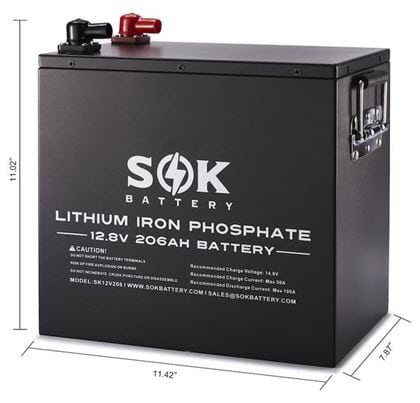
Figure 2. SOK LiFePO4 12.8V 200AH Battery – SOK Battery
Weight & Size
This battery model came in with a heavier but yet easy-to-handle weight of 47,6lbs, with dimensions of 10.83×7.87×11.22in.
Battery Capacity & Current
The SOK 200Ah has a capacity of 2,636Wh or 206Ah at an operating voltage of 12.8V. It has the same maximum charge current and discharge current as the SOK 100Ah model and can also be connected in series or parallel.
Internal design, Built-in Smart BMS & Higher Life Cycle and Warranty
All these features and specs of the SOK 200Ah battery are similar to the 100Ah battery model, with the only exception of being bigger and wider in design.
SOK Batteries vs. Lion Energy UT 1300
So, now that we can understand the specs and features of the SOK battery models, we can compare both SOK models with The Lion Energy UT 1300 battery, a leading LiFePO4 battery competitor.
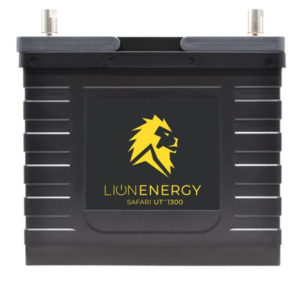
Figure 3. Lion Energy UT 1300 Battery- Source: Lion Energy
Size & Weight
The Lion Safari UT 1300 battery features a weight of 23lbs and a size of 10.2×6.6×8.8in, making the Lion Energy battery a lighter and smaller battery when compared with both SOK battery models, which means it is easier to handle.
Operating specifications
Batteries from the Lion Energy battery provide a maximum charge current of 100A and a maximum discharge current of 150A and up to 900A for surges. The SOK batteries have the same maximum charge current of 50A and discharge current of 100A and up to 200A for surges. In this aspect, SOK batteries can’t stand against the Lion Energy Battery. The Lion Energy battery is more suitable for applications that need higher instantaneous currents to work medium size DC or induction motors. However, refrigerators or freezers with lower surge currents could be powered using the SOK batteries.
SOK models have a temperature performance of (-22~140°F) for discharges and (32~140°F) for charges and a BMS Low/High-temperature cut-off of 32°F/149°F respectively. On the other hand, Lion batteries have an operating temperature range of (32~113°F) for charges and a range of (-4~131°F) for discharges.
The three batteries have a charge voltage of 14.6V. At the operating voltage of 12.8V, the competitor Lion Safari battery has a capacity of 105Ah. The SOK 100Ah battery has a slightly lower capacity than the Lion Safari, but it’s cheaper and can withstand higher temperatures.
Warranty & lifecycles
Lion Safari battery warranty surpasses standards by providing lifetime warranties and ensuring the proper functioning of the battery for a minimum of 3,500 cycles (100% DOD). On the other hand, both SOK batteries provide a 7-years warranty, but both ensure the proper functioning of the battery for a minimum of 4,000 (100% DOD) cycles and a lifetime of customer support. In normal usage (80% DOD) Lion Energy battery provides 5,000+ cycles while the SOK batteries provides 8,000+ cycles.
Depth of discharge (DOD) indicates the percentage of the battery discharged relative to the overall battery capacity.
The SOK batteries have more charge and discharge cycles than the Lion Energy battery before losing performance. In other words, SOK lasts longer than the Lion Energy battery.
Prices
While the Lion Energy battery has similar operating specifications to the SOK 100Ah battery model, the price is almost double ($999), while the 100Ah costs $500. The SOK 206Ah battery is $1029, a similar price to the Lion Energy product but with more capacity, making SOK batteries a much cheaper option.
SOK Batteries vs. Battle Born
Now we will compare specifications and features of SOK batteries models with batteries from another leading competitor, Battle Born, specifically the 100Ah 12V LiFePO4 Deep Cycle Battery.
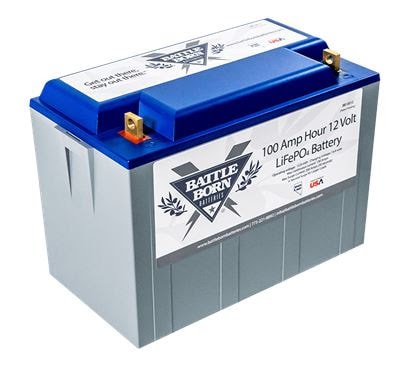
Figure 4. Battle Born 100Ah 12V LiFePO4 Deep Cycle Battery – Source: Battle Born
Size & Weight
The Battle Born 100Ah battery surpasses the weight of the SOK 100ah battery with 31lbs and exceeds the length of both SOK batteries with its dimensions of 12.76×6.86×8.95in, making Battle Born heavier and larger yet narrower than both SOK models.
Operating specifications
Battle Born 100Ah batteries provide a discharge current of 100A, a charge current of 50A, and up to 200A for surges, the same currents that both SOK batteries have. The Battle Born battery has an operating temperature range of -4°F to 135°F and BMS Low/High-temperature cut-off of 25°F/135°F respectively. They also have water resistance which is a feature that SOK batteries don’t.
When comparing the 100Ah SOK battery to the Battle Born one, both batteries have the same discharge/charge/surge currents and capacities. Temperature performances are also very similar to one another. The only difference would be that the Battle Born battery has water resistance, making it more suitable for marine applications than the SOK model.
Warranty & lifecycles
The Battle Born batteries have a 10-years warranty and work at least 3000 cycles (5000+ at 80% DOD). The SOK models are far more durable batteries; however, they have three years less warranty coverage than the Battle Born one.
Prices
Battle Born battery has similar operating specifications to the SOK 100Ah battery model but has a 50% higher price ($799). On the other hand, the SOK 206Ah battery costs $1029 but has way more capacity than the Battle Born battery.
Conclusion
The Lion Energy battery has better design features, currents, and warranty, but the SOK battery models still count with high-quality features that guarantee you higher lifecycles at a much lower cost. Battle Born’s features are similar to the 100Ah SOK ones; however, the Battle Born one has lower lifecycles.
The Battle Born battery is also more expensive than the SOK 100Ah model and only surpasses SOK models in warranty coverage and resistance against water. If we make a balance out of this, the SOK batteries will provide you similar specs, will last longer, and cost much less for the equivalent amount of energy, making SOK batteries a much better choice than the Battle Born ones.
Both SOK models are great options if you are looking for a battery for any application of mid and high-demand.
We hope you liked this article. Please rate it or leave us a comment.
Average rating 3.9 / 5. Vote count: 8
No votes so far! Be the first to rate this post.

